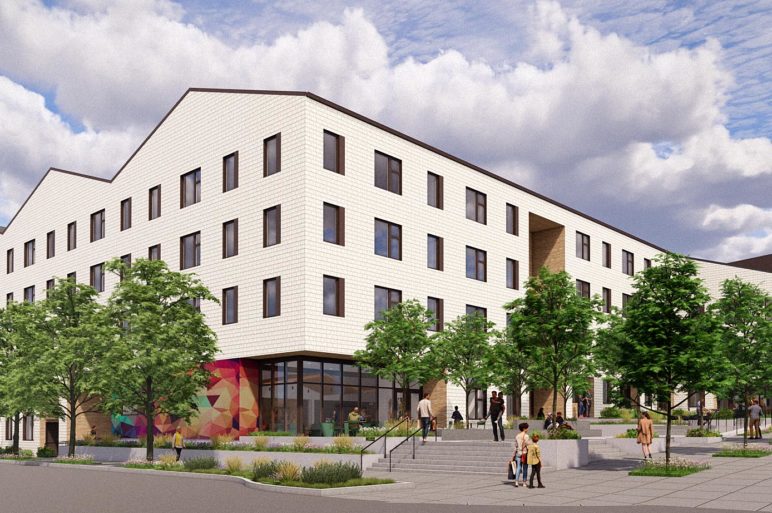This article is part of the series Parking? Lots!
Update, July 21: Oregon’s Land Conservation and Development Commission unanimously approved these rules on a permanent basis. The first round of parking reforms, removing mandates near transit, for smaller homes, and for regulated-affordable homes, are set to take effect Jan. 1, 2023, in the state’s eight largest metro areas.
About 100 years ago, governments started redesigning cities around cars. On Thursday, Oregon could approve a major step to prioritize space for people and businesses again, and reduce pollution in the process.
At the heart of its effort: sharply reducing urban and suburban parking mandates.
These little-known laws that make parking lots mandatory spread quickly and quietly across the rich world, including Cascadia and nearly all of North America, in the mid-twentieth century. They banned projects that included less than a certain, often arbitrary number of parking spaces. This in turn made it illegal or prohibitively expensive to create homes, shops, or offices in many places where driving is less necessary.
In effect, parking mandates declare a parking space to be more important than a home or a job.
Oregon’s proposed reform would begin to reverse that. Over the next three years, it would give the 53 jurisdictions in the state’s eight largest metro areas—the urbanized areas in and around Albany, Bend, Corvallis, Eugene, Grants Pass, Medford, Portland, and Salem, home to about two-thirds of the state’s population—various options for rolling back or eliminating their decades-old parking mandates, especially in designated “climate-friendly areas” (CFAs). The CFAs, whose borders would be drawn by most of the jurisdictions over the next few years, would also allow mixed-use buildings of up to four stories and see higher standards for walking, biking, and transit investments.
Mandatory parking: ‘A self-fulfilling prophecy’
Parking mandates aren’t the main reason we have parking lots, of course. We have parking lots because cars are useful and, in many cases, necessary. And Oregon isn’t considering a ban on parking lots, new or old.
But the effect of mandatory parking lots is to keep cars necessary. By forcing buildings apart and driving up the cost of adding homes, shops, and offices to walkable areas, parking mandates make it illegal for cities to ever voluntarily evolve away from auto dependence.
Parking mandates ban new Main Streets by requiring each new 2,000-square-foot cafe to be surrounded by 5,000 square feet of parking lot. They keep buildings vacant. They drive up the rent in new apartments by hundreds of dollars a month and kill the incentive of landlords and employers to save everyone money by coordinating shared cars or discounted transit passes. They induce deadly heat islands and, by forcing new buildings to be spread out, literally cast modern auto dependence into stone.
“There’s always this assumption that everyone wants to have a car, but it’s, like, a self-fulfilling prophecy,” said Sergio Cano, 40, a middle-school social studies teacher in Albany, Oregon, in an interview last week. “We need to stop that cycle at some point.”
‘Fewer people and destinations are walking distance’
Cano, who said his own family owns cars and expects to always need to, nevertheless submitted testimony supporting the parking reforms last fall. It was part of the Oregon Department of Land Conservation and Development’s two-year process to update statewide transportation and land use rules. Oregon calls the project “Climate-Friendly and Equitable Communities.”
The project comes out of Oregon’s 50-year tradition of state-led land use planning. It’d be the state’s latest effort to enforce its law requiring jurisdictions within metro areas to “encourage the availability of adequate numbers of needed housing units at price ranges and rent levels which are commensurate with the financial capabilities of Oregon households.” Among other things, the state also requires its metro areas’ transportation systems to “minimize adverse social, economic, and environmental impacts and costs,” “conserve energy,” and “meet the needs of the transportation-disadvantaged.”
Cano’s was one of hundreds of comments on the proposal received by the commission, its members, and its staff since the project launched in April 2020.
Another came from Oregon-based transit planner Michelle Poyourow. At the land use commission’s March hearing, she explained how parking requirements undermine transit service in cities like Grants Pass and Wilsonville.
“When buildings are further apart, that means fewer people and destinations are walking distance from any given bus stop,” Poyourow said. “This actually causes bus routes to be more circuitous, less direct, and less frequent.”

In some cities, the stakes are even higher. Eleanor Ponomareff serves as city council president in Talent, where 2020’s Alameda fire destroyed 800 homes and much of the central city. As Ponomareff told the commission last September, the fire compounded a pre-existing deficit of affordable housing.
“As we rebuild, my constituents are asking for new development that is climate–friendly, less auto–dependent, more affordable and equitable, and in short, a city that is hospitable for everyone,” Councilor Ponomareff said. “It makes no sense for us to continue to both prioritize and subsidize auto dependency and expect our climate and housing issues to go away.”
Most new buildings will have parking whether or not it’s required

Some parts of Oregon have already made parking optional. Tigard, just southwest of Portland, removed parking mandates from the “Tigard Triangle”, an area named for the shape of three roadways that enclose it, in 2018. Since then, the Triangle has seen three new buildings go in: all multi-story apartment buildings, two of them with ground-floor retail and two with regulated affordability. All three were built with parking, with 194 new spaces among them. That’s plenty of parking—but it’s also a bit less than they would have previously been required to construct. In short, the Tigard Triangle can now start the gradual process of evolving into a more transit-oriented neighborhood. At least five more buildings are now on the way.
This open-option parking exists elsewhere in Oregon, too. Central districts in Ashland, Corvallis, Eugene, Salem, and Tigard have made parking once again optional. Portland removed virtually all residential parking mandates from its apartment zones in 2020 and from lower-density zones in 2021. Still, even in Portland—the least auto-dependent part of the state, largely because it has the most buildings constructed before the age of automobiles—most new buildings include parking, especially farther from the city core. But, as in the Tigard Triangle, Portland has opened a door to gradual change.
Opponents: Rules would restrict surface parking
Oregon’s proposal has its detractors. This month, a coalition led by statewide advocacy groups for suburban developers, real estate agents, large businesses, and bankers launched a website attacking the rule package, including its parking reforms. The group said the changes would “make it harder to find parking” and that by “disallowing vehicular parking, circulation, access, display, or loading on-site between buildings and public streets,” the proposal “up-ends decades of commercial development patterns, and may severely impact car dealerships, service stations, freight access, and any other auto-oriented business.”
The critics are correct that, in addition to allowing less parking to exist if people want, Oregon would also impose several costs on new parking lots in urban areas. The critics object to new state requirements that surface parking lots larger than one-quarter acre be at least half-covered by tree canopy (to reduce heat islands), or else pay for a certain number of new solar panels. They object to a requirement to construct electric capacity for 40 percent of the spaces in new residential parking lots to one day charge electric vehicles. They object to new rules that would, within the to-be-designated climate-friendly areas and near frequent transit, prohibit very large surface parking lots.
Critics also raise concerns about various rules not related to parking. In addition to legalizing four-story mixed-use buildings throughout future climate-friendly areas, the rules essentially ban new single-detached homes and duplexes in those areas. That’s a relatively mild form of a “minimum density standard,” which could indeed be counterproductive in some situations.
Beyond the industry-led group, the proposal has drawn criticism from some people who sometimes park a car in the street and feel it’d be annoying if other people were allowed to save money by doing the same. It’s also drawn warnings from some elected officials who say they’ll get an earful from those people.

Tualatin Mayor Frank Bubenik summed things up to the land use board in March. “We just had two contentious land use hearings,” he recounted. “Apartment residents complained about the existing shortage of parking and were totally against additional units being constructed with minimal parking spots.”
Parking reform has a lot of fans

The parking reform proposal also has a coalition of supporters. Maybe that’s no surprise, since public polling shows that reducing parking mandates seems to be fairly popular with Pacific Northwest voters.
A group of 35 nonprofits from around Oregon, convened by Sightline, have co-signed a letter in support of the parking proposals. Supporters include affordable housing providers such as REACH Community Development and Bienestar; environmentalist and environmental justice groups like Verde, OPAL Environmental Justice Oregon, the Sierra Club’s Oregon chapter, and Portland Audubon; tenant advocates like the Springfield Eugene Tenant Association and Portland: Neighbors Welcome; business advocates like Beaverton Downtown Association and Business for a Better Portland; transportation reformers like Oregon Walks, Bend Bikes, and Better Eugene Springfield Transportation; and anti-sprawl groups like 1000 Friends of Oregon and Central Oregon Landwatch.
Many of those signers are also part of a separate coalition that has, like Sightline, endorsed the full package of changes that includes the parking reform.
Why do such a wide variety of Oregonians support lower parking mandates? Maybe for the same reason that parking mandates were so easily and quietly created, 60 to 70 years ago. Each unnecessary parking space alone doesn’t harm very many people very much, at least in the short term. So requiring buildings to have more parking than they’ll need, just in case, can seem prudent.
But those same requirements to overbuild parking harm many different people in many different ways. Especially over the long term.
“We’ve heard from an unusually diverse set of interests, from affordable housing advocates to conservation folks to local government folks, that this is an important step,” said Evan Manvel, the state planner who’s managed the parking reform proposal. “Parking mandates impose hidden costs on everyone.”
Correction 6/9: An earlier version of this article misstated the number of affected jurisdictions. Unincorporated county land is affected only if a county has at least 5,000 residents inside both its urban growth boundary and any Metropolitan Planning Organization boundaries.



Comments are closed.